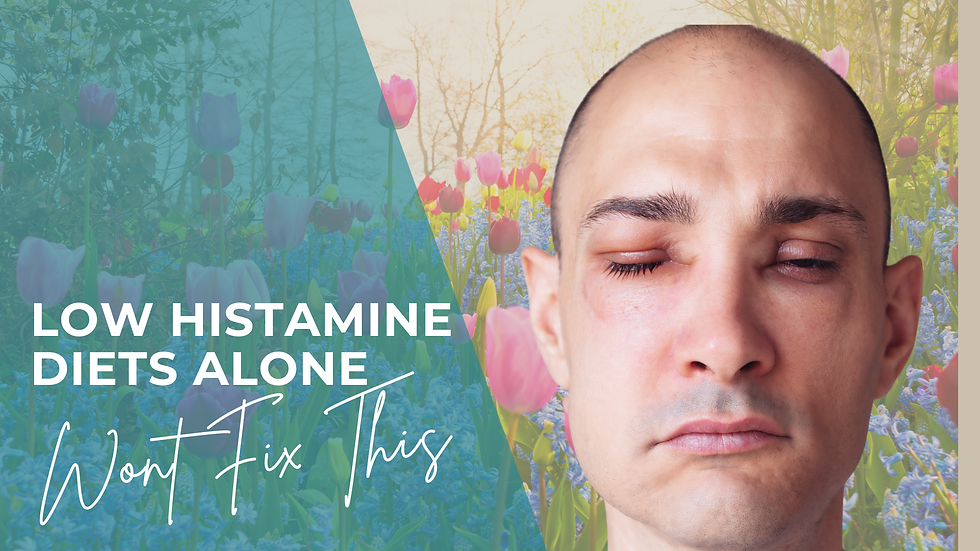Think You Have Adrenal Fatigue? It Might Be Something Deeper
- Dig Nutrition
- Apr 20
- 4 min read

You wake up tired. Not just groggy—bone-deep tired.You rally through the day with caffeine and grit, but by 3 PM, your body says: nope.And when it’s finally time to sleep? You’re wired. Brain buzzing. Scrolling. Planning. Replaying.It’s frustrating. It’s disorienting. And it makes you question your own resilience.
Have you ever paused to wonder why your body’s doing what it’s doing? Not just how to fix it—but what it might be responding to?
Cortisol doesn’t overreact—it overcompensates. It adapts to what it believes is needed, even if the pace isn’t sustainable.
Cortisol often gets reduced to a “stress hormone,” but it’s far more nuanced. It’s the pace setter—governing energy, sleep cycles, blood sugar, inflammation, and immune rhythm. It operates with quiet precision, responding to the world your body senses.
Think of it like a thermostat. It’s constantly adjusting to what’s happening around and within you—trying to keep you regulated, responsive, alive. But when the signals never quiet down—when the room feels like it’s always on fire—cortisol doesn’t shut off. It keeps dialing up… until the system itself starts to short.
When Cortisol Loses Its Rhythm, So Do You
This is what dysregulation can look like:
High cortisol (overdrive):
Wake up with anxiety or dread
Nighttime insomnia (especially between 2–4 AM)
Midsection weight gain, especially if your diet is “clean”
Salt or sugar cravings
Digestive issues like reflux or bloating
Restlessness, tension, a feeling of being “on edge”
Low cortisol (burnout):
Trouble getting out of bed—even after 8+ hours of sleep
Brain fog and emotional flatness
Afternoon crashes
Frequent colds or long recovery times
Coffee feels like a lifeline
Feeling disoriented, unmotivated, or not quite yourself
Sometimes, you’ll swing between both ends—revved up, then burned out.Other times, it’s a slow descent into depletion you didn’t see coming.
What’s Really Behind “Adrenal Fatigue”
Many people searching for answers land on the term adrenal fatigue—and while it’s not a medically recognized diagnosis, it speaks to something real: the way your body adapts (and eventually depletes) under chronic stress. What’s actually happening is more often a disruption in your cortisol rhythm, driven by a stressed-out HPA axis.
This isn’t just about “being stressed.” It’s about how long your body has been trying to adapt.
Common drivers I see all the time:
Blood sugar crashes from skipped meals or low-protein diets
Lingering gut issues, inflammation, or stealth infections
Mold or toxin exposure
High-intensity workouts with no restorative balance
Late nights, screen time, and circadian disruption
Emotional stress, unresolved trauma, or chronic “overdoing”
When the body doesn’t feel safe—physically, emotionally, or environmentally—cortisol stays on the job.
But that job isn’t meant to be 24/7.
The Power of Testing: Getting Honest Data Instead of Guesswork
A one-time blood cortisol test won’t tell you the whole story. What you need is a map.
Tests like the DUTCH hormone panel or a 4-point saliva cortisol test track your cortisol rhythm over the course of a day. This gives us insight into when it spikes, when it drops, and how consistent your rhythm really is.
Knowing your rhythm allows us to design a support plan that restores—not overrides—your natural tempo.
Where to Start: Small Shifts, Real Signals
The goal isn’t to eliminate all stress. That’s not realistic—or even necessary.The goal is to retrain your body to respond differently. To recover faster. To trust that it’s safe to slow down.
Here’s where I recommend starting:
1. Balance Your Blood Sugar
Eat a protein-rich breakfast—within an hour of waking
Avoid skipping meals, especially if you feel depleted
Minimize refined sugar and ultra-processed snacks
2. Honor Your Body’s Need for Rest
Wind down before 10:30 PM (your cortisol naturally rises again after that)
Use soft lighting in the evening
Magnesium glycinate, glycine, or ashwagandha can support your body’s ability to downshift
3. Use Adaptogens Intentionally
High cortisol? Try holy basil, rhodiola, or phosphatidylserine
Low cortisol? Licorice root (short-term), vitamin C, and targeted adrenal nutrients
4. Let Movement Support You—Not Deplete You
High cortisol? Try walking, stretching, or light mobility
Low cortisol? Use resistance training sparingly to rebuild capacity
5. Help Your Nervous System Feel Safe
Practice slow breathing (inhale 4, hold 4, exhale 8)
Get sunlight in the morning to anchor your circadian rhythm
Prioritize joy, play, and human connection—it’s physiological, not optional
Cortisol isn’t something to hack or fight. It’s something to listen to.
When you begin to read its signals—its timing, its patterns—you shift from controlling the body to collaborating with it. You move from fixing to attuning.
This is the beginning of body literacy. Of reclaiming rhythm. Of learning to trust what your system has been trying to communicate all along.
And in that shift, something powerful happens:
You stop asking, What’s wrong with me?
And begin asking, What is my body trying to tell me?
That question alone can change everything.
🎯 Ready to See What Your Cortisol is Really Doing?
If you're tired of feeling like you're doing all the “right” things and still feel off, it might be time to stop guessing.
Book a free strategy session and let’s find out what your stress response is telling us—and how we can help you restore your rhythm.





Comments